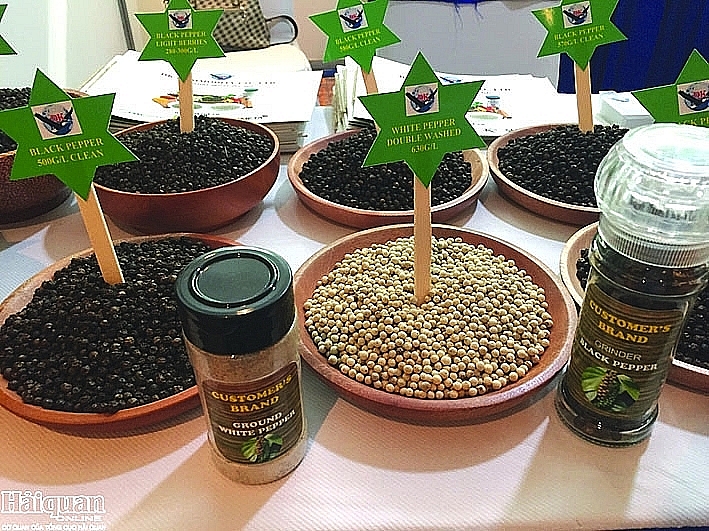 |
| Vietnam needs to promote the development of organic pepper products. Photo: N.H |
Great potential and advantages
According to the Vietnam Pepper and Spices Association (VPSA), the export turnover of pepper and spices reached more than US$ 1.4 billion in 2022, contributing more than US$ 55 billion in turnover of agricultural, forestry and fishery exports in 2022.
In the first quarter of 2023, Vietnam exported 76,727 tons of pepper, with a total turnover of US$ 235.9 million. Compared to the same period last year, it increased by 40.5% in volume but decreased by 7.3% in value. Along with that, cinnamon was 18,685 tons with US$ 54.8 million, up 45.8% in volume and 13.8% in value. Anise was 3,369 tons with US$ 21.6 million, up 261.9% in volume.
VPSA estimated that Vietnam’s pepper production in 2023 would increase by about 5% compared to 2022. Vietnam’s pepper crop in 2023 was expected to increase to 225,000 tons compared to the estimated 200,000 tons of last year’s crop.
Meanwhile, according to the International Pepper Association (IPC), the harvest from other producing countries such as Brazil, Indonesia and India was forecast to decrease compared to 2022. Total global pepper production in 2023 was estimated at 526,000 tons compared to 537,600 tons in 2022. Vietnam’s cinnamon output in 2023 was forecast to increase compared to 2022 and was estimated at about 45,000 tons. This is one of Vietnam’s advantages in the international arena.
However, recently, the import markets have continuously had warnings about pesticide residues as well as increased frequency of control and tightening of MRLs for food in general, including spices of Vietnam.
Assessing the situation of Vietnamese spices exported, Director of the Forestry Production Development Department (General Department of Forestry, Ministry of Agriculture and Rural Development) Nguyen Van Dien said that natural conditions created spices such as cinnamon, pepper, and anise, which are ranked in the top 5 in the world. Over the years, the spice industry made important contributions to the overall picture of agricultural exports. Specifically, this was a commodity industry associated with more than 1 million farmer households producing raw materials. There was great potential and advantages, but the journey to achieve the goal of supplying good spices to the world was hard.
Because although the leading enterprise in the industry had taken the lead in applying production technology in the world which helped Vietnam have certain brands, up to now, the production area of spices in Vietnam was still small, fragmented, with a lack of linkages. Therefore, it was still difficult to create a seasoning material area. Besides, meeting the requirements on quality and residues of pesticides in export markets.
Identifying challenges
Referring to the specific regulations in exporting spices that enterprises are facing, Mr. Le Nhat Thanh, Director of the Post-Import Plant Quarantine Centre I, Department of Plant Protection, said that the chili product was mainly exported to Malaysia, China.
Although each market had detailed regulations on different standards, in general, the planting areas were required to have codes, and good agricultural practices (GAP) and be recognized. Planting areas and packing facilities must be registered with the competent authority. The product must ensure residues of pesticides do not exceed the regulations of the import market.
Agreeing with the above view, Ms. Nguyen Thi Quyen, representative of the Initiative for Sustainable Trade (IDH) Vietnam, also said that the biggest challenge for pepper exports was pesticide residues and cinnamon exports were heavy metal residues. In addition, there were environmental challenges such as reducing carbon emissions, encouraging sustainable farming models, and sustainable intercropping models. In addition, there were social challenges such as child labour and gender equality.
In the opinion of experts, along with the increase in frequency of control for agricultural products in general including Vietnam’s spices, supporting enterprises to access information on market and commodity, knowing the regulations of the state management agencies of Vietnam as well as the regulations of the importing country is essential.
In addition, geopolitical factors may be the main cause of price volatility rather than supply and demand factors. The import market’s strict requirements and regulations on non-tariff barriers continue to increase. The unpredictable evolution of climate change will be the main challenge for the global agricultural sector.
“In the context of fierce trade competition, technical barriers from import markets (quality requirements, pesticide residues), VPSA must make more efforts in properly implementing function as a solid support for enterprises, conducting seminars, trade promotion. Enterprises must be a pillar for farmers, especially in connecting planting areas and processing areas, increasing the value of Vietnam’s spices. In the future, the Ministry of Agriculture and Rural Development will study and develop additional mechanisms to support the spice association industry, create legal products and materials and meet the world’s requirements,” the Director of the Forestry Production Development Department said.
